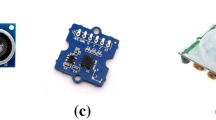Abstract
Visual impairment can be congenital, or acquired, and is classified as low vision or blindness. In both cases, the person passes through daily difficulties, such as the ability to recognize objects and people, which implies insecurity and mobility problems. Several assistive technologies have been developed over the years (walking sticks, guided dogs, and electronic devices that assist in mobility) aiming to contribute to the integration of the visually impaired into society and guarantee more independence. This work proposes a wearable echolocation system for obstacle detection through wireless sensing modules, which uses a microcontroller with information that allows determining the distance between obstacles and the user that is wearing the device. Moreover, it provides the user with tactile and auditory feedback related to this distance, enabling him to perceive the approach of objects or living beings, even without the ability to interpret visual signals. For this purpose, an experimental protocol was developed, which was carried out by visually impaired volunteers, with the approval of the ethics committee for studies with human beings (CAEE: 09844219.9.0000.5208), to assess usability and validate the prototype. The validation of the equipment was done through the statistical analysis of the results obtained from questionnaires applied to the volunteers submitted to the experiments. The results showed that 83.33% of the participants said they were at least satisfied with the mobility assistance provided by the prototype and 66.67% were at least satisfied with the confidence in the mobility promoted by the navigation assistant system developed in the first use of the equipment. The developed prototype was validated and its applicability as a navigation assistant for the visually impaired was verified. Ensuring easy use and freedom of movement, enabling improvement in the mobility of the individual.
Access this chapter
Tax calculation will be finalised at checkout
Purchases are for personal use only
Similar content being viewed by others
References
IBGE at https://www.ibge.gov.br/
WHO Global data on visual impairment at https://www.who.int/blindness/globaldatafinalforweb.pdf?ua=1
WHO World report on vision at https://apps.who.int/iris/bitstream/handle/10665/328717/9789241516570-eng.pdf?
Shoval S, Ulrich I, Borenstein J (2003) NavBelt and the guide-cane obstacle-avoidance systems for the blind and visually impaired. IEEE Robot Autom Mag 10:9–20
O'keeffe R, Gnecchi S, Buckley S et al (2018) Long range LiDAR characterisation for obstacle detection for use by the visually impaired and blind. In: IEEE 68th electronic components and technology conference (ECTC), San Diego, CA, pp 533–538
Dhod R, Singh G, Kaur M (2017) Low cost GPS and GSM based navigational aid for visually impaired people. Wireless Pers Commun 92:1575–1589
Bai J, Lian S, Liu Z, Wang K et al (2018) Virtual-blind-road following-based wearable navigation device for blind people. IEEE Trans Consum Electron 64(1):136–143
Cardin S, Thalmann D, Vexo F (2007) A wearable system for mobility improvement of visually impaired people. Vis Comput 23:109–118
Patil K, Jawadwala Q, Shu FC (2018) Design and construction of electronic aid for visually impaired people. IEEE Trans Hum Mach Syst 48(2):172–182
Xiao J, Joseph SL, Zhang X et al (2015) An assistive navigation framework for the visually impaired. IEEE Trans Hum Mach Syst 45(5):635–640
MSP430x2xxx Texas Instrument datasheet at https://www.ti.com/lit/ug/slau144j/slau144j.pdf
HC-SR04 Ultrasonic Ranging Module datasheet at https://cdn.sparkfun.com/datasheets/Sensors/Proximity/HCSR04.pdf
nRF24L01 Single Chip 2.4GHz Transceiver nordic semiconductor datasheet at https://infocenter.nordicsemi.com/pdf/nRF24L01P_PS_v1.0.pdf
C1027B001D Jinlong machinery and electronics datasheet at https://www.vibration-motor.com/products/coin-vibration-motors/coin-vibrations-motors-with-brushes/c1027b001d
DFRobot DFPlayer Mini at https://wiki.dfrobot.com/DFPlayer_Mini_SKU_DFR0299
Ramadhan AJ (2018) Wearable smart system for visually impaired people. Sensors (Basel) 18(3):843. https://doi.org/10.3390/s18030843
Katzschmann RK, Araki B, Rus D (2018) Safe local navigation for visually impaired users with a time-of-flight and haptic feedback device. IEEE Trans Neural Syst Rehabil Eng. 26(3):583–593. https://doi.org/10.1109/TNSRE.2018.2800665
Acknowledgements
This work had the support and general supervision of the GPEB (Research Group in Biomedical Engineering) and the CEI (Center for Inclusive Studies), both from UFPE (Federal University of Pernambuco, Brazil).
Conflict of Interest
“The authors declare that they have no conflict of interest”.
Author information
Authors and Affiliations
Corresponding author
Editor information
Editors and Affiliations
Rights and permissions
Copyright information
© 2022 Springer Nature Switzerland AG
About this paper
Cite this paper
Silva, Mç.B.C., Bispo, B.C., Silva, C.M., Cunha, N.A., Santos, E.A.B., Rodrigues, M.A.B. (2022). Assisted Navigation System for the Visually Impaired. In: Bastos-Filho, T.F., de Oliveira Caldeira, E.M., Frizera-Neto, A. (eds) XXVII Brazilian Congress on Biomedical Engineering. CBEB 2020. IFMBE Proceedings, vol 83. Springer, Cham. https://doi.org/10.1007/978-3-030-70601-2_212
Download citation
DOI: https://doi.org/10.1007/978-3-030-70601-2_212
Published:
Publisher Name: Springer, Cham
Print ISBN: 978-3-030-70600-5
Online ISBN: 978-3-030-70601-2
eBook Packages: EngineeringEngineering (R0)




